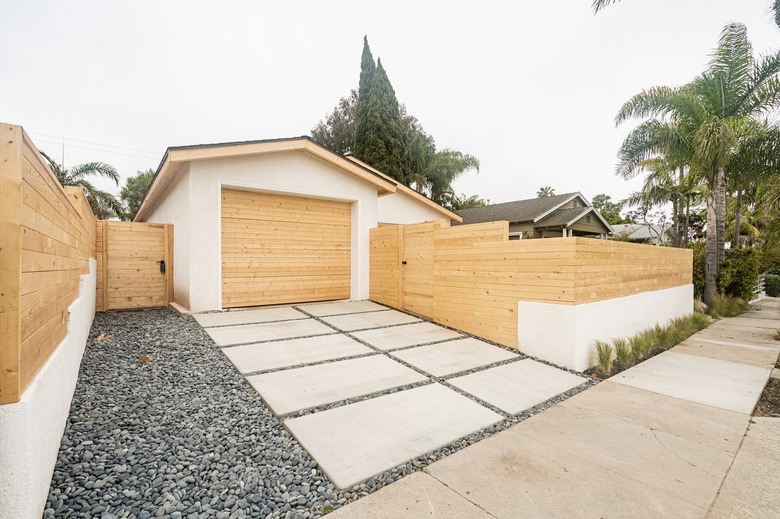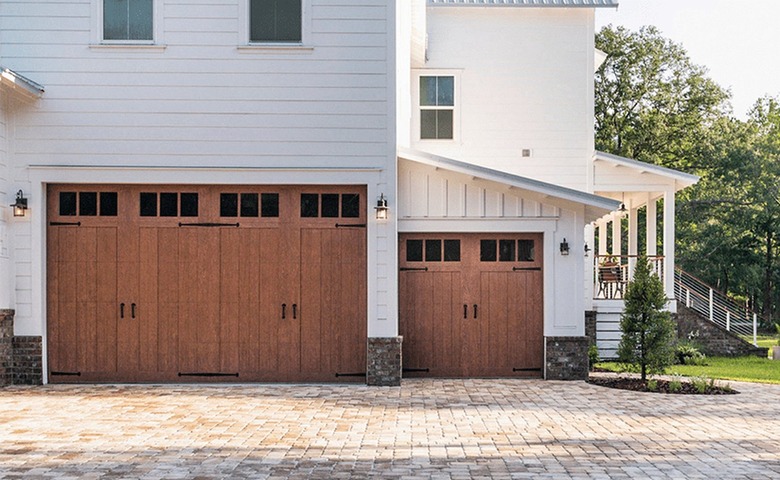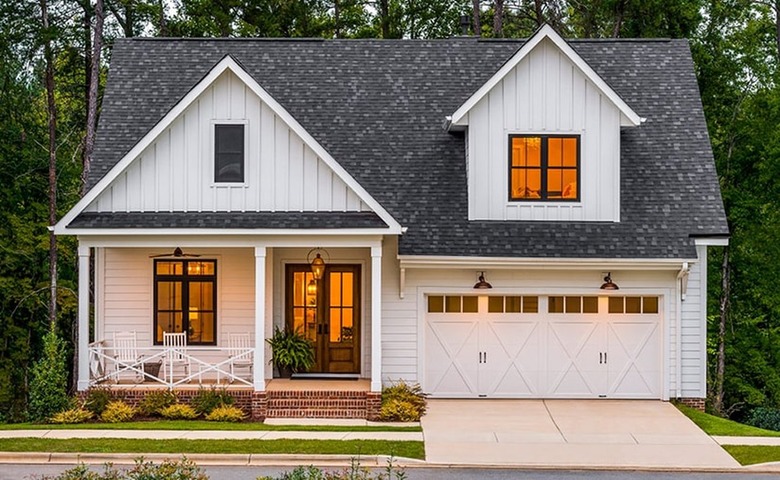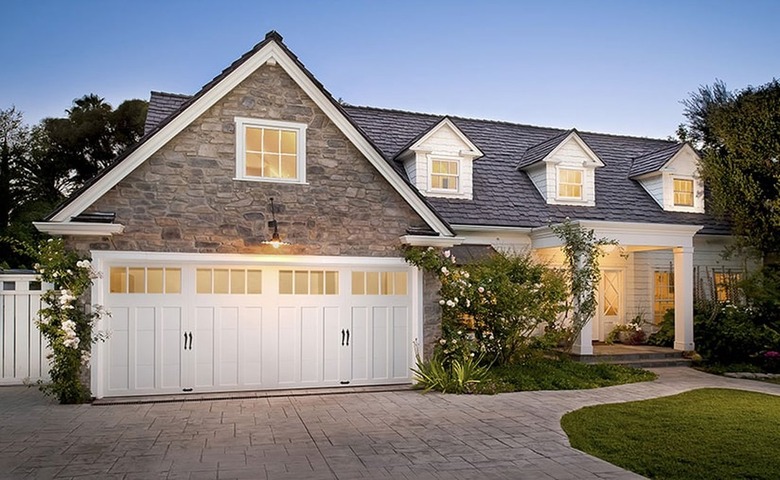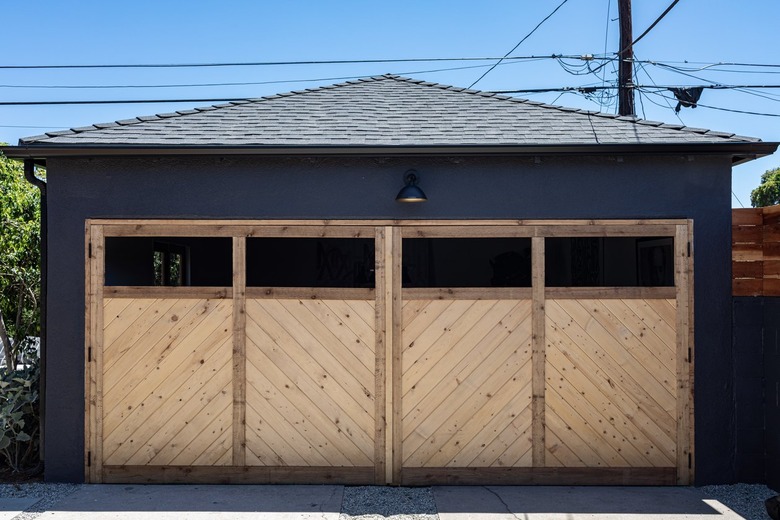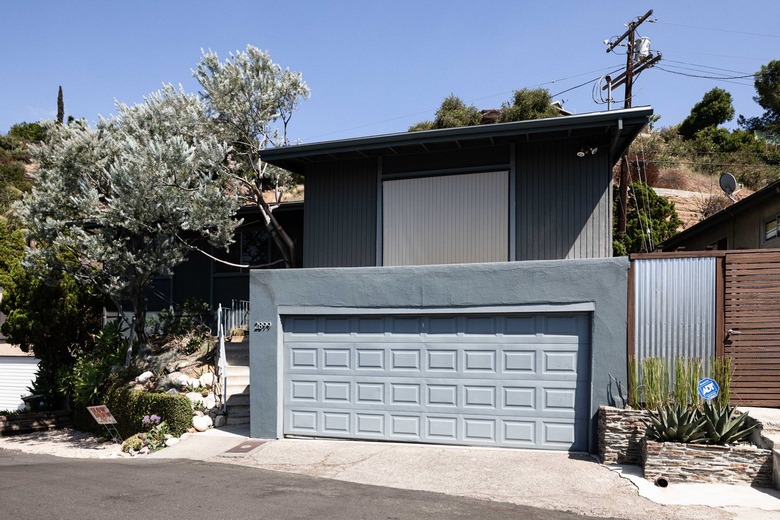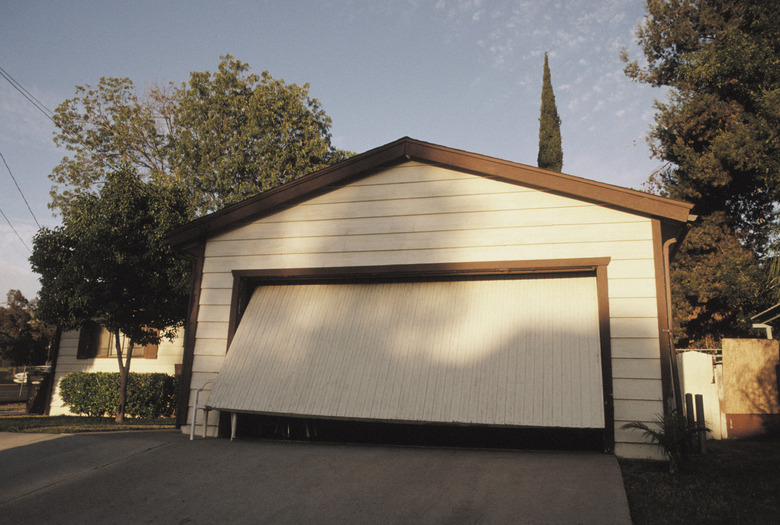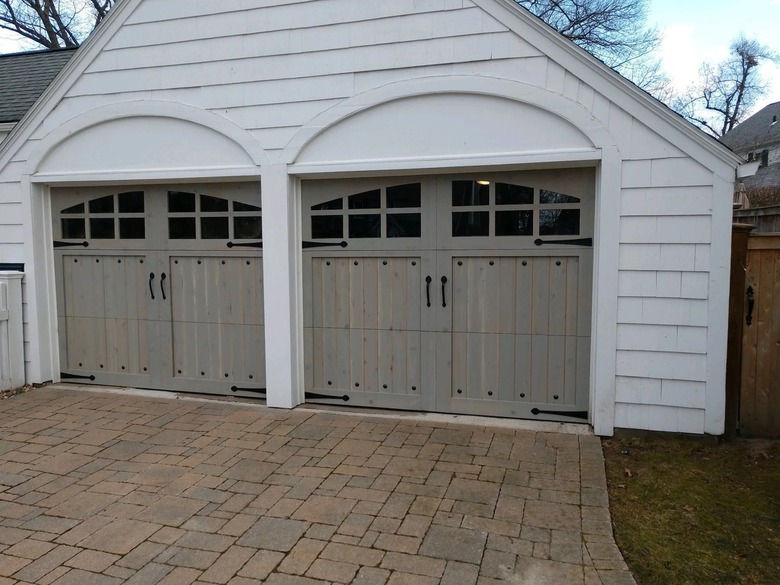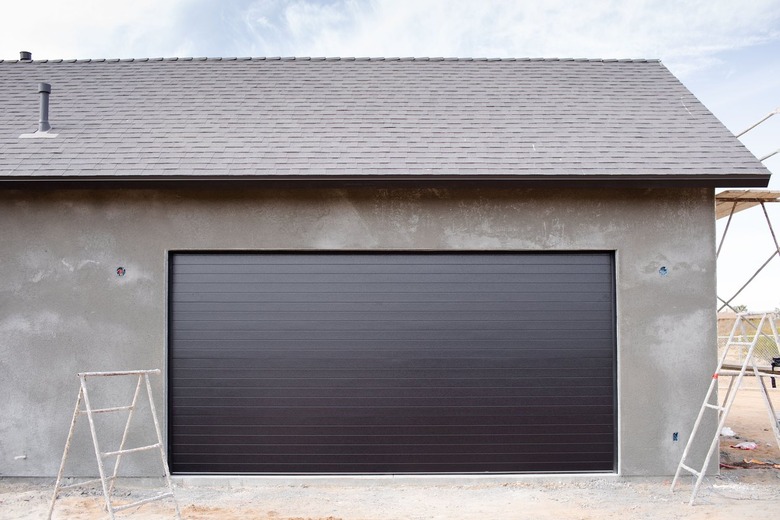The 5 Best Garage Door Styles For Your Home
We may receive a commission on purchases made from links.
Your garage door could take up as much as a third of the front exterior of your home, which is why its appearance should matter just as much as its functionality. But before buying a new garage door, do your research on the different garage door styles on the market to help you understand the various designs, opening methods, materials, and costs. This way, you can find the right option based on your budget, home style, climate, and more.
1. Traditional
1. Traditional
Garage doors with raised or indented panels are considered to have a traditional style, which is why you've likely seen these types of garage doors everywhere. The decorative details may be painted to match or may be colored a contrasting hue from the rest of the door. These doors may or may not be decorated with windows.
2. Carriage
2. Carriage
A garage door is considered a "carriage-style" even if it doesn't actually swing open in the center. Homeowners who don't think they can afford a carriage door are often able to achieve the same look at a lower price with a sectional door featuring carriage detailing, such as handles and hardware in contrasting colors. Carriage styling looks quite attractive on historical homes, such as those with Victorian, Tudor, Spanish colonial, or colonial designs.
3. Barn
3. Barn
A subset of carriage-style garage doors are those with crossbeams, like classic barn doors. These doors are most commonly found in white, natural wood stains, or with the cross beams featuring a color that contrasts with the rest of the door. They are most attractive on houses with craftsman, cabin, ranch, or similar rustic styling.
4. Colonial
4. Colonial
These garage doors are intended to match the styling of a classic colonial home. This means they typically appear to be made from wood, though they may be constructed with other materials, such as steel, fiberglass, or wood composite. Many but not all are designed to look like a carriage door, but they may have a tilt-up, sectional, or carriage opening functionality regardless of their appearance. Colonial-style doors are most commonly white in color and frequently (but not always) feature windows.
5. Contemporary
5. Contemporary
While other garage door styles are well suited for homes with a historical look, a modern home needs a garage with contemporary styling to match. While designs vary, modern-style garage doors have a sleek, flat surface, and windows and other accents typically emphasize horizontal lines. Contemporary garage doors are most commonly made with aluminum and glass, though wood and steel are also popular options.
If you can't find a stock door option that meets your needs, you can have your garage door customized, though these options will significantly add to the budget. Semicustomization options are available to make simple changes, such as adding windows to the design or choosing a nonstock paint color. If you have very specific ideas in mind, you may need to have the item fully custom-ordered. As an example, choosing a nonstandard color might add $500 to the price, but adding windows and choosing a custom color could add $1,600 to your bill. On the other hand, having a completely custom-ordered garage door could cost you upward of $5,500.
Garage Door Opening Methods
Garage Door Opening Methods
When most people think about garage doors, they envision what it will look like but not necessarily how it will open. However, it's important to remember that how your door opens isn't just a matter of functionality but also appearance. Here are the most common garage door opening methods:
Sectional
The most popular type of garage door opening method, sectionals are also called multipanel doors. They consist of interconnected horizontal panels secured between two parallel tracks with rollers. Sectional garage doors may or may not feature windows and can be colored and styled in a variety of ways. These are the most inexpensive garage doors, and stock models can be found for as little as $550.
Tilt-up
Sometimes called single-panel garage doors, tilt-up doors open outward, requiring more clearance than sectional doors. They were the most popular garage door option in the 1960s and 1970s. While they have fewer working parts and therefore break down less frequently than other types of garage doors, when they do break down, they can collapse and cause serious property damage and bodily injury. Tilt-up garage doors are reasonably inexpensive and cost upward of $850.
Carriage or Swing Style
Both a design style and an opening method, carriage — or swing-style — doors open outward like historical stable doors. Their vertical lines look elegant and often blend in with the rest of the home, but they require a lot of clearance to swing out and are more expensive than other types of doors, particularly when automated. For manual doors, expect to pay upward of $3,750, but for automated doors, prices can easily go upward of $5,500.
Roll-up
For those who want their garage door to take up as little space as possible, a roll-up door, sometimes called a coiling door, offers many of the same benefits as a sectional garage door, only it rolls into a tight coil just above the garage door opening. Because they are installed against the wall rather than secured to the ceiling, they are a good option for tall garages or for those who need to access overhead storage space in their garage. Roll-up garage doors are a little more expensive than sectional doors, coming in upward of $950.
Common Garage Door Materials
Common Garage Door Materials
When shopping for a garage door, it's important not just to consider the different types of garage door opening methods and styles but also the different materials available. That being said, if you like the appearance of a material, such as natural wood, keep in mind that you may be able to achieve the same appearance with a different material that may provide other benefits, such as a lower price tag, better durability, increased insulation, etc.
Steel
The most popular material used in modern garage doors is steel, which is usually sold with either a smooth finish or an embossed wood-grain pattern. Steel garage doors typically feature two or more layers of galvanized steel, and these layers may be backed with insulation to increase the door's strength and energy efficiency, giving the door an R-value (or how well the insulation can keep in heat) between 5 and 10.
The steel is typically covered in an enamel with UV protection to protect it from damage from sunlight, rain, snow, wind, and other weather conditions. Additionally, the enamel means upkeep simply involves rinsing down the door a few times a year to remove dirt, mud, and salt residue. Steel doors are lightweight, sturdy, and inexpensive, with prices starting at $400, and limited warranties may last 10 years to a lifetime.
Aluminum
Aluminum garage doors may not be quite as strong as steel, but they are impervious to rust, making them a good option in areas where steel can be damaged by salt debris from snowy roads or from salty ocean air. That being said, aluminum is easily damaged by heavy winds, hail, and other fast-flying objects.
Aluminum frames may be fitted with either aluminum or glass panels or a combination of the two, and because aluminum is notably strong and lightweight, it makes an ideal frame for glass paneling. Glass, like aluminum, is impervious to weather conditions, but it can be broken with a heavy enough impact, though the glass used in these doors is typically tempered to better protect it from damage. Both aluminum and glass have poor insulation on their own, but aluminum can be fitted with additional insulation, and glass may be available with double panes and gas fills to add to the R-value.
The light weight of aluminum makes it ideal for manual doors, so if you live in an area prone to power outages, it may be your best option. Like steel, aluminum can mimic the appearance of wood and is very low maintenance. It requires nothing more than a quick wash here and there to maintain its appearance, while glass-paneled doors are cleaned in the same manner as windows in your home. Aluminum garage doors start at around $400, whereas glass-paneled doors start at around $1,000. The warranty for both aluminum garage doors and aluminum doors with glass panels is about 1 year long.
Wood
Once the most common of all garage door materials, wood is now a less popular option, largely because it requires routine painting or sealing. Less expensive wood doors are made from a composite material consisting of a wood frame over fiberboard sheets, which may have an overlay that mimics the look of solid wood. Composite doors sometimes have polystyrene insulation between the fiberboard panels. Doors built from solid woods, typically Douglas fir, redwood, or cedar, are also available, with nicer woods typically available through custom order only.
Factory-made composite wood garage doors typically have a warranty of only one year, whereas custom solid wood doors usually have longer warranties that last around 15 years. It's best to avoid purchasing a wood garage door if you live in a very moist environment where snow, rain, or humidity could cause the wood to become warped, but even in dry environments, it's best to keep up with regular staining, painting, and/or finishing of the material in order to maintain its beauty and protect it from fading, rotting, and warping. Composite is typically a little less expensive than real wood and may start at $750, whereas the price for solid wood will typically start at around $1,000, though custom solid-wood doors will cost dramatically more, starting at around $5,000.
Fiberglass
Fiberglass garage doors are typically made by bonding two layers of fiberglass to a steel frame filled with polyurethane insulation. This provides increased rigidity and strength without adding significant weight. Fiberglass is an increasingly popular material for garage doors since it mimics the look of solid wood better than just about any other material and is impervious to rust, termites, and warping. It is also resistant to denting and cracking. This makes it a lower-cost alternative to wood (prices start at $850) that performs well even in the most humid environments and requires practically no maintenance. Unfortunately, fiberglass can break upon impact, and if damaged, it must be replaced entirely rather than repaired, so it is not recommended for windy areas or homes with kids. This is also why the limited warranty only lasts three years.
Vinyl
Vinyl garage doors are made by putting a vinyl skin over a steel frame and can mimic real wood appearance particularly well. They are lightweight, quiet, durable, low maintenance, and inexpensive, with prices starting as low as $700. They are impervious to rust, termites, rot, and dents. They are difficult to break, and they contain UV-resistant additives, meaning they won't fade under direct sunlight. Another benefit is that they offer notably longer warranties than most products, lasting up to 20 years.
Extra Insulation
Most garage door materials can be fitted with additional insulation, typically polystyrene or polyurethane foam. If you have an attached garage and live somewhere with cold weather, this may be a worthwhile investment, though you can expect the price to go up to around $400. Insulation values vary based on the original material, the insulation material, and the thickness of the insulation, but the R-value of insulated doors usually ranges from 4 to 19, with the price increasing along with the R-value. It is worth insulating a garage door only if your garage itself is insulated, and the door is sealed around the edges.
How Much Do Garage Doors Cost?
How Much Do Garage Doors Cost?
On average, expect a new garage door to cost anywhere from $500 to $2,500. A stock door with no windows can cost anywhere from $500 to $1,000, while a midrange model with some insulation and decorative elements may cost between $800 and $2,500. A high-end garage door that's insulated and either partially or fully customized will cost upward of $1,500. Expect a double-car garage to cost 15 to 40 percent more than a single-car garage.
Aside from the cost of your garage door, you should also budget an additional $300 for labor related to the installation and another $1,000 or so for hardware, such as springs, hinges, bolts, tracks, and a lock. For an electric garage door, also factor in an additional $250 to $600 for the garage door opener and its installation. Removal and disposal of the old garage door can add $50 to $250 to the total cost.
